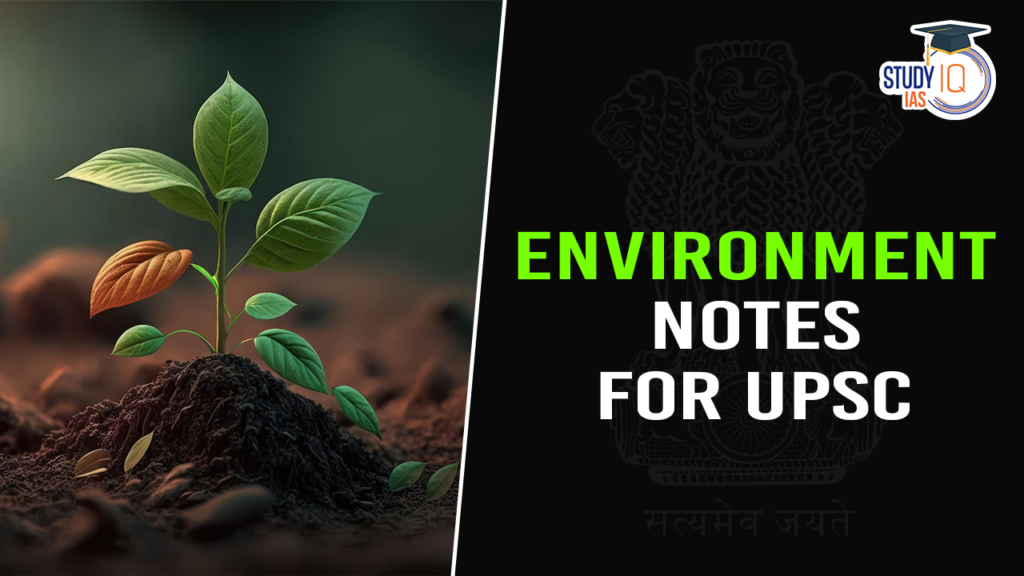
Environment Notes for UPSC
Environment is included in both the UPSC CSE (Main) GS III Paper and the General Studies section of the Prelims exam. The weighting of the environmental topic has grown since 2013 when the Indian Forest Services Prelims Exam were integrated with the UPSC Civil Services Prelims. The environment topic can come up in up to 33% of the questions on the General Studies paper, so it is crucial to prepare it thoroughly.
Second, having a solid understanding of this subject will assist aspiring bureaucrats to ensure that they are able to apply their knowledge in formulating policy. Challenges like global warming and climate change have grown to be some of the most significant challenges of the 21st century.
Environment and Ecology
- Revolution of Clean Energy in India and Current Status
- List of National Parks in India 2025, Check State-wise List
- Bone Collector Caterpillar Wears the Body Parts of the Dead
- Mahuadanr Wolf Sanctuary: India’s First Wolf Sanctuary in Jharkhand
- Similipal Tiger Reserve (STR) Notified as 107th National Park of India
- Antibiotic Pollution in Rivers, Reasons and its Impacts
- National Environmental Engineering Research Institute (NEERI)
- Tiger Reserves in Madhya Pradesh List and their Key Features
- Colossal Squid Resembles a ‘glass sculpture’ in First Footage
- Study links Climate Cange with Rising Arsenic Levels in Rice
UPSC Environment Notes
Environment & Ecology is one of the important subjects of civil services examination. In both the UPSC Prelims and Mains, questions from this section have been asked often. It is crucial to take notes on crucial environmental themes in preparation for the IAS Exam. Both the UPSC Prelims Syllabus and the UPSC Mains Syllabus (GS III) cover themes pertaining to the environment. Environment-related subjects can occasionally be included in the IAS Mains Essay paper.
You can use the relevant articles on environment and ecology on this page to help you with your preparation for the Civil Services Exam.
Environment and Ecology
- Environment and its Types
- Components of Environment
- Ecology, its Principles and Types
- Ecological Succession and its Types
- Ecosystem, its Function and Types
- Biomes
Biodiversity
- Biodiversity, its Levels, Extent and Significance
- Biodiversity Loss-Extent, Causes and Impact
- Biodiversity In India
- Biogeographic Zones in India
- Biodiversity Hotspots in India
- Initiatives for Biodiversity Conservation Global
- Initiatives for Biodiversity Conservation Indian
- Species Based Conservation Programme in India
- Ramsar Sites in India
Environmental Issues
- Desertification
- Soil Erosion
- Pollution and Its Types
- Waste Management
- Air Pollution
- Water Pollution
- Ozone Depletion
- Noise Pollution
- Radioactive pollution
Climate Change
- Greenhouse Gases
- Global Warming
- Climate Change and Its Impact
- Climate Change Adaptation and Mitigation
- Indian Initiatives to Address Climate Change
- Ocean Warming
- Land Degradation
Clean Energy
- Solar Energy
- Wind Energy
- Hydro Energy
- Bio Energy
- Methanol
- Hydrogen Energy
- Geothermal Energy
- Ocean Energy
Sustainable Development
- Introduction to Sustainable Development
- Sustainable Development Goals
- SDG and Challenges in achieving SDGs in India
- Green Economy
- Blue Economy
Environment Protection Movements in India
International Environmental Conventions and Protocols
- List of Environmental Conventions and Protocols
- Ramsar Convention
- Vienna Convention
- Kyoto Protocol
- Intergovernmental Panel on Climate Change
- United Nation Environment Programme
Important Laws on Environment Protection in India
National Parks in India
- Eravikulam National Park
- Valley of Flower National Park
- Periyar National Park
- Rajaji National Park
- Nagarhole National Park
- Dachigam National Park
- Jaldapara National Park
- Orang National Park
- Pench National Park
- Sanjay Gandhi National Park
- Bannerghatta National Park
- Manas National Park
- Dudhwa National Park
- Jim Corbett National Park
- Kaziranga National Park
- Ranthambore National Park
- Gir National Park
- Kuno National Park
- Kanha National Park
- Bandipur National Park
- Bandhavgarh National Park
Biosphere Reserve in India
Tiger Reserves and Bird Sanctuaries in India
- Sariska Tiger Reserve
- Pilibhit Tiger Reserve
- Parambikulam Tiger Reserve
- Mudumalai Tiger Reserve
- Periyar Tiger Reserve
- Pench Tiger Reserve
- Valmiki Tiger Reserve
- Panna Tiger Reserve
- Nagarahole Tiger Reserve
- Bandipur Tiger Reserve
- Anamalai Tiger Reserve
- Buxa Tiger Reserve
- Kanha Tiger Reserve
- Sathyamangalam Tiger Reserve
- Amrabad Tiger Reserve
- Bandhavgarh Tiger Reserve
- Ramgarh Vishdhari Tiger Reserve
- Satpura Tiger Reserve
- Melghat Tiger Reserve
- Ranipur Tiger Reserve
- Satkosia Tiger Reserve
- Ranthambore Tiger Reserve
- Amangarh Tiger Reserve
- Tadoba Tiger Reserve
- Bird Sanctuaries in India
Environment UPSC Preparation
The syllabus for current events, science and technology, and geography overlaps significantly. Consequently, you will undoubtedly have a competitive advantage in the other subjects if you successfully complete the environment and ecological portion of the syllabus. Here is the pre-planning method developed by professionals in StudyIQ:
- Read the Syllabus: Look at the course outline for that subject and make an effort to study it so you can map out the contents in your head. You’ll be able to weed out pointless reading material and maintain your preparation’s focus if you do this.
- Look over the Previous Year Questions: PYQs will provide you with a fundamental idea of the difficulty of the questions that are asked, enabling you to choose your resources wisely.
- Read Biology NCERT Class XII: The final four chapters of this book provide a clear explanation of all the fundamental ideas. As a result, reading them would familiarise you with some terms that might appear on the test.
Current events Another crucial area in relation to environmental and ecological issues is current affairs. Take notes from editorials from the Hindu and articles from periodicals like Yojana and Kurukshetra. After that, keep editing them so you remember the ideas.
Environment UPSC Syllabus
Environment is every living and non-living thing that surrounds us as well as interacts with us in our day-to-day life. Environment is the natural component in which biotic (living) and abiotic (non-living) factors interact among themselves and with each other. These interactions shape the habitat and ecosystem of an organism.
In a biological sense, the environment constitutes the physical (nutrients, water, air) and biological factors (biomolecules, organisms) along with their chemical interactions (chemical cycles – carbon cycle, nitrogen cycle etc.) that affect an organism or a group of organisms. All organisms are dependent on the environment to carry out their natural life processes and to meet their physical requirements (food, energy, water, oxygen, shelter etc.).
| Chapter | Topics |
| Conservation | What is Biodiversity?, Types of Biodiversity – Genetic, Species, Ecosystem, etc., Importance of Biodiversity – Ecosystem Services, BioResources of Economic Importance, Social Benefits, etc., Reasons for Loss of Biodiversity
Conservation: In-situ & Ex-Situ, Eco-Sensitive Areas, Ecological Hotspots, National Guidelines, Legislations & Other Programmes. International Agreements & Groupings |
| Environmental Pollution & Degradation | Types of Pollution & Pollutants, Impact of Pollution & Degradation
Ozone Layer Depletion and Ozone Hole, Greenhouse Gas Effect & Global Warming, Eutrophication, Desertification, Acid Rain, Hazardous Waste, etc. Causes/Sources of Pollution & Degradation, Prevention & Control of Pollution & Degradation, National Environment Agencies, Legislations and Policies International Environment Agencies & Agreements |
| Environmental Impact Assessment (EIA) | What is EIA?, Indian Guidelines & Legislations, EIA Process, Need & Benefits of EIA, Shortcomings of EIA in India, Measures to Make EIA Effective |
| Disaster Management | Types of Disasters, Management of Disasters, Community Level Disaster Management, Government Initiatives on Disaster Management |






















